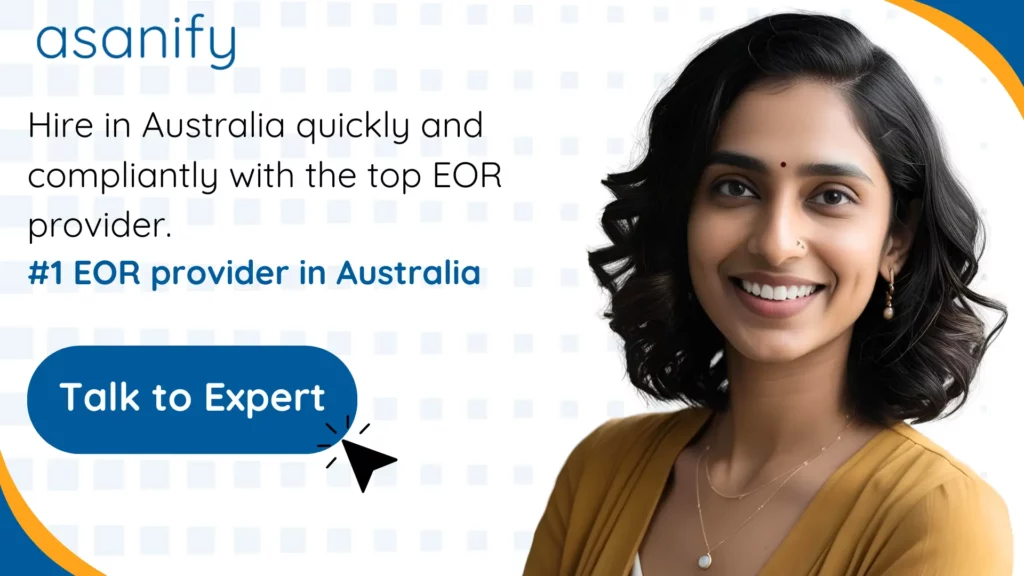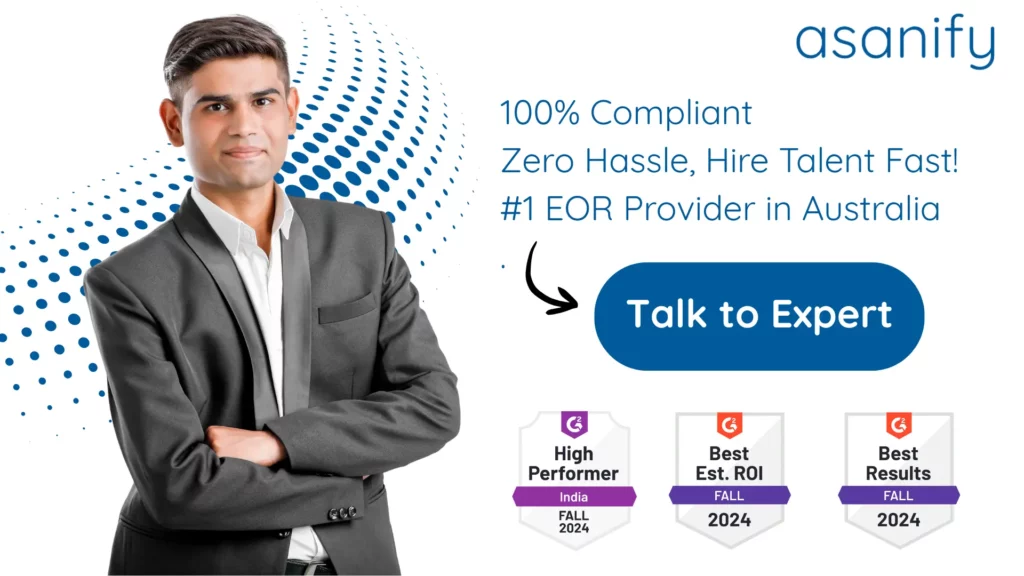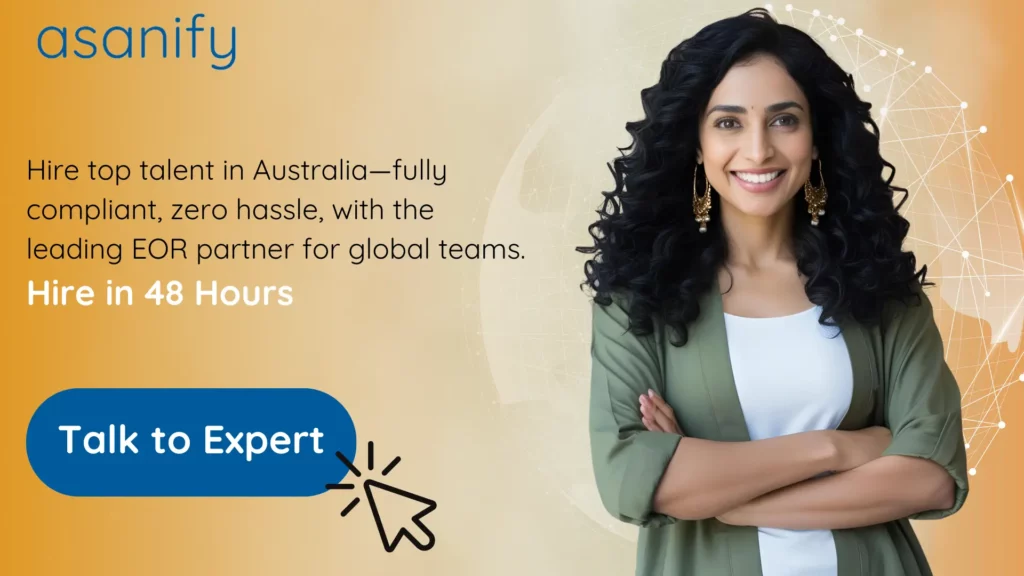Australia’s strong economy, high quality of life, and demand for skilled talent make it one of the top destinations for international workers. Whether you’re expanding your business operations or hiring in Australia, understanding Australia’s work authorization process is critical to compliance and efficient onboarding. Partnering with an Employer of Record can help businesses hire talent in Australia quickly, without the need to set up a local entity.
Table of Contents
- Overview of Australia’s Work Permit and Visa System
- Understanding Requirements and Eligibility
- Who Needs a Work Visa in Australia
- Key Conditions for Obtaining an Australian Work Visa
- Employer and Employee Eligibility
- Types of Work Visas and Permits in Australia
- Comparing Work Visa Types
- Advantages of the Temporary Skill Shortage Visa (Subclass 482)
- Application Process for Employers
- Required Documents
- Processing Timelines
- Employer Responsibilities and Compliance
- Legal Obligations
- Consequences of Non-Compliance
- Maintaining Ongoing Compliance
- Tips for a Smooth Application Process
- How an Employer of Record Can Help
- How Asanify Can Help
- FAQs
Overview of Australia’s Work Permit and Visa System
Australia regulates the employment of foreign nationals through the Department of Home Affairs. Visa requirements vary depending on the worker’s skills, nationality, and the nature of employment.
- Australian citizens and permanent residents – Can work without restrictions.
- Foreign nationals – Must hold a valid work visa before starting employment.
- Employer-sponsored process – Many visas require the employer to nominate the worker before they can apply.
- Multiple visa categories – Temporary and permanent options based on skill shortages and job type.
- Points-tested and nomination-based – Some visas use a skills points test, others require direct employer nomination.

Understanding Requirements and Eligibility
Before applying, both employers and employees should understand Australia’s work authorization framework. The correct visa depends on the job role, skill level, and intended duration of stay.
- Determine if the position falls under the skilled occupation list.
- Check whether employer sponsorship or nomination is required.
- Ensure the applicant meets English language and skills assessment requirements.
Who Needs a Work Visa in Australia
Any non-Australian citizen or permanent resident must hold a valid work visa to be employed in Australia.
- Citizens and permanent residents – No work visa required.
- Unauthorized work can lead to fines, deportation, and visa bans.
- Short-term and seasonal workers also require appropriate visas.
- Most visas are employer-specific and role-specific.
- Dependents may need separate visas to work.
Key Conditions for Obtaining an Australian Work Visa
Applicants generally must:
- Have a valid job offer from an eligible Australian employer.
- Meet skills, qualification, and work experience requirements.
- Demonstrate English language proficiency.
- Pass health and character checks.
Employer and Employee Eligibility
Employers must be approved sponsors to hire foreign workers for certain visa subclasses. Employees must meet the minimum skills and licensing requirements for their role.
Key Points:
- Employer must be registered as a Standard Business Sponsor (SBS) for sponsored visas.
- Occupation must be on the approved skilled occupation list.
- Some roles require skills assessments from recognized authorities.
- Non-compliance can result in loss of sponsorship rights.
Suggested Read: Understanding Labour Laws in Australia : A Complete Guide 2025
Types of Work Visas and Permits in Australia
Australia offers a range of work visas for foreign employees:
- Temporary Skill Shortage Visa (subclass 482) – For filling skill shortages with foreign talent.
- Skilled Employer Sponsored Regional Visa (subclass 494) – For regional employers.
- Employer Nomination Scheme Visa (subclass 186) – For permanent residency through employer sponsorship.
- Skilled Independent Visa (subclass 189) – Points-tested permanent visa without employer sponsorship.
- Working Holiday Visa (subclass 417/462) – For young workers on cultural exchange programs.
Comparing Work Visa Types
| Visa Type | Purpose | Duration | Notes |
| Subclass 482 | Fill skill shortages | Up to 4 years | Requires employer sponsorship |
| Subclass 494 | Regional skilled work | Up to 5 years | Leads to permanent residency |
| Subclass 186 | Permanent work | Permanent | Employer nomination required |
| Subclass 189 | Independent skilled work | Permanent | Points-tested; no sponsorship required |

Advantages of the Temporary Skill Shortage Visa (Subclass 482)
This is the most common visa for employer-sponsored workers in Australia. It allows multiple entries, can be renewed, and may lead to permanent residency through subclass 186.
- Suitable for high-demand skilled roles.
- Employer sponsorship streamlines approval.
- Can include family members as dependents.
- Pathway to permanent residency after meeting criteria.
Application Process for Employers
The process typically starts with the employer applying for sponsorship approval (if not already an approved sponsor). Then, the employer nominates the foreign worker for a specific position. Once the nomination is approved, the worker applies for the visa online.
Required Documents
- Sponsorship approval or employer registration proof.
- Signed employment contract.
- Skills assessment results (if applicable).
- English language test results.
- Proof of qualifications and work experience.
Processing Timelines
- Sponsorship and nomination: 4–8 weeks.
- Visa application: 1–3 months, depending on the subclass and applicant’s location.
- Total process: 2–5 months on average.
Employer Responsibilities and Compliance
Employers must follow Australia’s labor and immigration rules when hiring foreign workers.
Legal Obligations:
- Pay market salary rates that meet the Temporary Skilled Migration Income Threshold (TSMIT).
- Provide safe working conditions.
- Keep accurate employment records.
- Notify the Department of Home Affairs of changes in employment.
Consequences of Non-Compliance:
- Fines and penalties.
- Loss of sponsorship approval.
- Potential legal action.
Maintaining Ongoing Compliance
- Track visa expiry dates.
- Renew sponsorship status when required.
- Ensure workers remain in approved roles and locations.

Tips for a Smooth Application Process
- Confirm the role is on the skilled occupation list before recruiting.
- Prepare all sponsorship and nomination documents in advance.
- Use the Department of Home Affairs’ visa processing guides.
- Consider working with an Employer of Record to simplify compliance.
How an Employer of Record Can Help
An Employer of Record in Australia enables companies to hire foreign employees without setting up an Australian entity. The EOR becomes the legal employer, handling payroll, benefits, compliance, manage contracts and visa sponsorship while you focus on managing daily operations.
Benefits include:
- Avoids the time and cost of entity registration.
- Ensures compliance with Australian labor laws.
- Manages work visa applications and renewals.
- Provides localized payroll and benefits administration.
Suggested Read: Employer of Record Australia: A Comprehensive Guide 2025
How Asanify Can Help
Navigating Australia’s work permit process can be complex, especially for overseas employers. Asanify’s Employer of Record (EOR) solution manages the entire process from securing the right work visa to managing payroll and HR compliance ensuring your business stays compliant without opening a local entity.
With Asanify, you can:
- Hire talent in Australia quickly and compliantly.
- Stay updated with changing visa and labor regulations.
- Expand into Australia without entity setup costs.
If your goal is to grow your team in Australia efficiently, Asanify makes it easy to tap into one of the world’s strongest job markets.
FAQs
Depends on the subclass—482 visas allow up to 4 years, while permanent visas have no limit.
Fees range from AUD 1,000 to AUD 4,000+ depending on the visa type and duration.
Yes, but they must hold the correct visa that allows work rights.
Subclass 482 visa for skilled roles where no local workers are available.
Yes, often through the subclass 186 Employer Nomination Scheme.
Yes, dependents can be included in most work visa applications.
The employee must stop working immediately, and the employer should arrange a renewal or cessation of employment.
An EOR ensures compliance, handles payroll, and manages visa sponsorship without requiring a local entity.
Not to be considered as tax, legal, financial or HR advice. Regulations change over time so please consult a lawyer, accountant or Labour Law expert for specific guidance.

